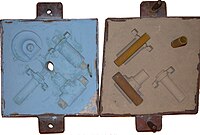
Photo from wikipedia
Metals remain essential structural materials for many demanding engineering applications requiring high strength at elevated temperatures and good performance in environments subjected to high thermal fluctuations such as often encountered… Click to show full abstract
Metals remain essential structural materials for many demanding engineering applications requiring high strength at elevated temperatures and good performance in environments subjected to high thermal fluctuations such as often encountered in the automotive, rail and aircraft industries. The sand-casting process is one of the most preferred methods of producing complex and intricate shaped components out of metals with good strength at elevated temperatures. Unfortunately, the sand casting process also leads to the direct and indirect production of carbon dioxide. Three-dimensional sand mold printing has been revolutionizing traditional production methods by reducing the unnecessary consumption of metal and chemicals when manufacturing a part through sand casting. This paper explores the opportunities that are emerging in the area of 3D printing of sand molds and the positive impact that these new technologies and practices are having on the environmental impact of current sand-casting processes. The paper demonstrates that 3D printing of sand molds enables new manufacturing strategies reducing the direct CO emissions and reducing the amount of metal required by enabling design optimization of both the component and mold/core assembly. Further benefits will be realized through the development of environmentally friendly binder systems.
Journal Title: Journal of Cleaner Production
Year Published: 2019
Link to full text (if available)
Share on Social Media: Sign Up to like & get
recommendations!